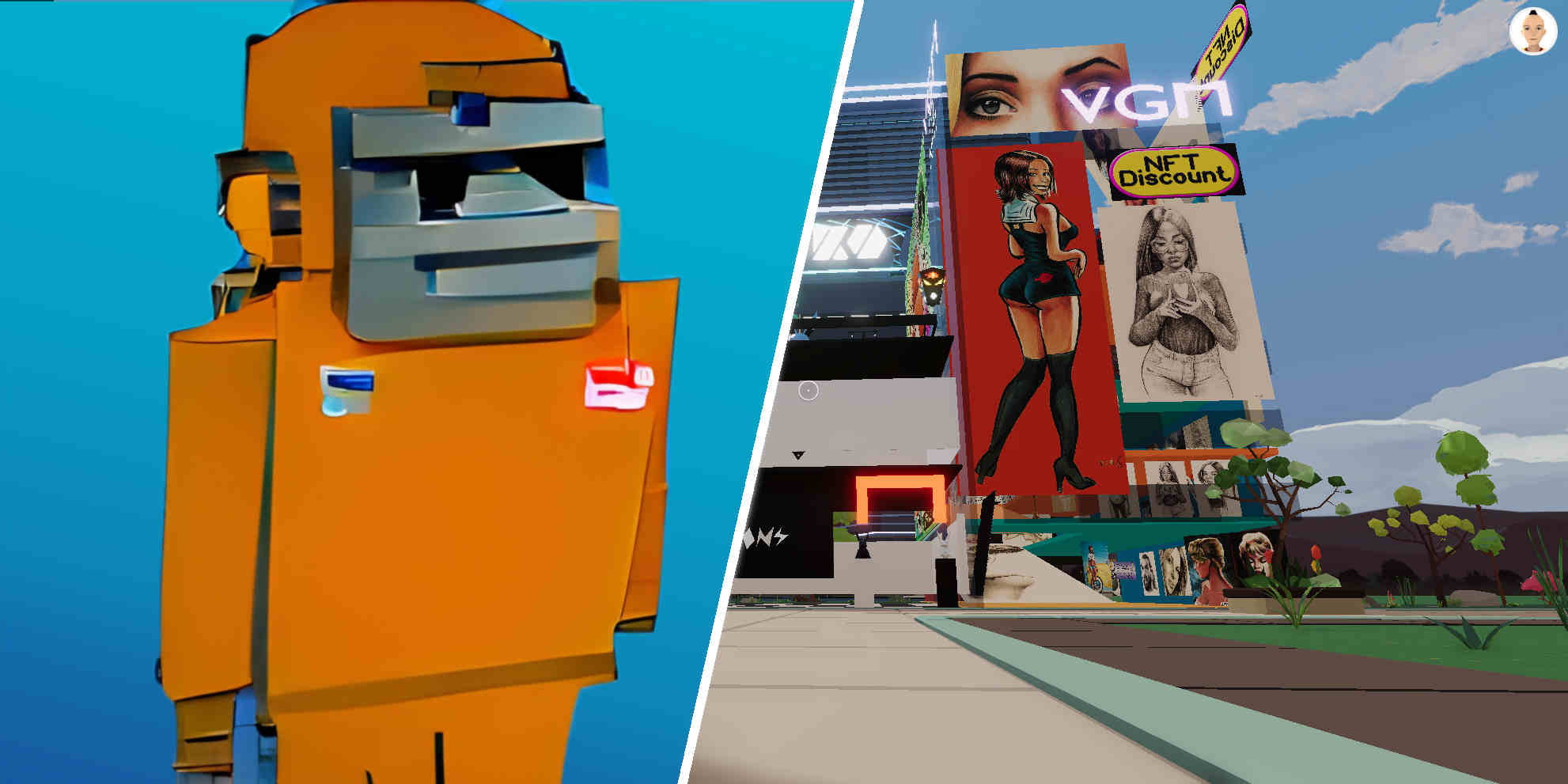Pro Senectute beider Basel, a foundation to help the elderly around Basel, launched its NFT project last week and already informed about its Metaverse commitment beforehand. According to a media release, Michael Harr, managing director of the 15-million Basel-based company, wants to use the purchase of these “properties” in a “central location” in two online worlds to promote solidarity between the generations and enable older people to use current and future digital technologies, promote their integration and reduce social isolation.
Diesen Artikel gibt es auch auf Deutsch 🇩🇪. Or read more blockchain-related stuff.
We wanted to take a look at what “central location” actually means in an online world called “Decentraland”. Decentraland measures 5 km by 5 km and the Pro Senectute presence can be found 500 m from the edge of the city, i.e. on the outer 10% of the buildable space. The view from the roof of the anarchy café right next door also screams anything but “central!”: a deserted environment as far as the eye can see and on the other side of the street a seemingly endless steppe. Neither walking around nor several return visits did change that.
But Michael Harr’s vision goes far beyond today: “Where will we reach older people in the distant future and how do get to interact with them?”
A behind-the-scenes look at metaverses and NFTs help us understand whether this goal can be achieved.
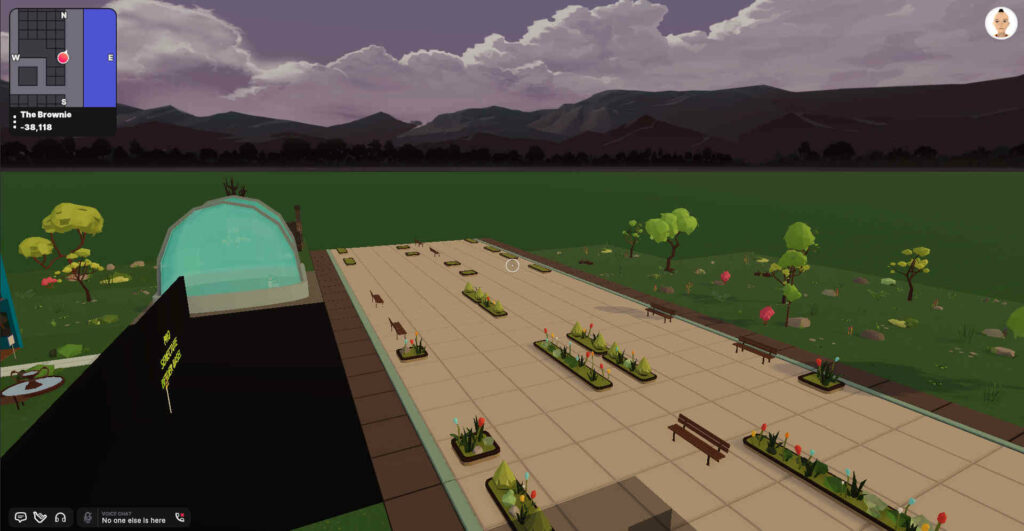
But what is the Metaverse?
According to Wikipedia, a metaverse is a digital space created by the interaction of virtual, augmented and physical reality. Neal Stephenson created the term 30 years ago for an online world that allows its users to escape, at least temporarily, from the dystopia of “Snow Crash.” The term “metaverse” became known to a wider audience when Facebook was renamed Meta.
More than 200 such virtual 3D experience spaces are offered by various companies today. Analogous to social media platforms, these metaverses also try to differentiate themselves from each other through incompatibility and lock-in mechanisms: “customer loyalty” by means of walled gardens.
Accordingly, customers also have to make multiple commitments. Pro Senectute beider Basel has acquired “plots of land in two of these metaverses, Decentraland and The Sandbox, with the vision of one day building a virtual course center or a virtual counseling center with a meeting place there” (Harr). Currently, metaverse architects are still being sought for this.
Let’s take a closer look at these two metaverses.
Metaverse 1: Decentraland
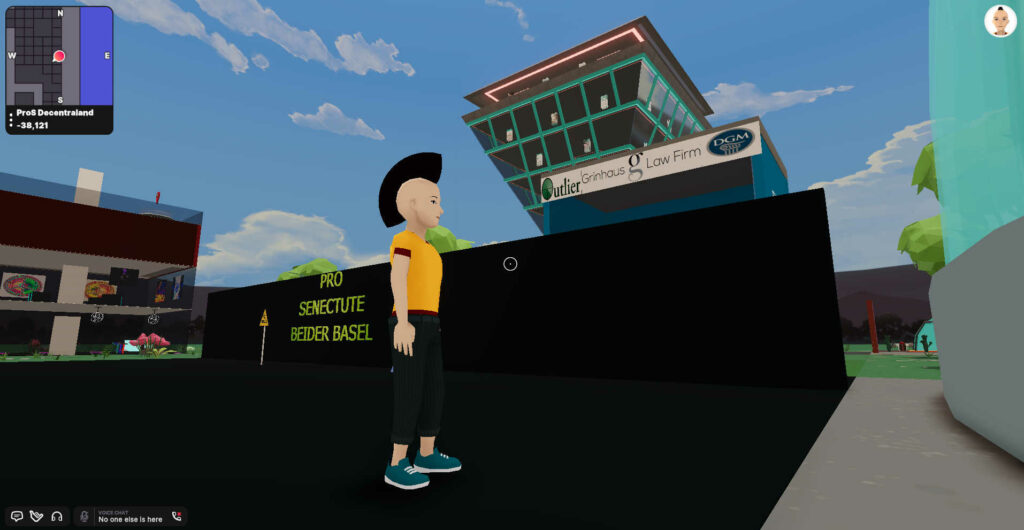
For new Decentraland users, getting started is a snap if you speak English: Visit play.decentraland.org in your browser and select that you want to play as a guest (and, depending on your computer, dismiss the message that your graphics performance is insufficient). Some loading time later you are greeted by an introduction that explains how to roam the virtual world with a combination of mouse and keyboard known from first person shooters. With a jump into the cold water (literally) you arrive in the city center with many buildings, but not a single other player.
Inexperienced in first person shooters, slightly disoriented, and annoyed by the sometimes suddenly materializing walls, I try to locate the “central location” (coordinates -38,120 and -38,121) on the map.
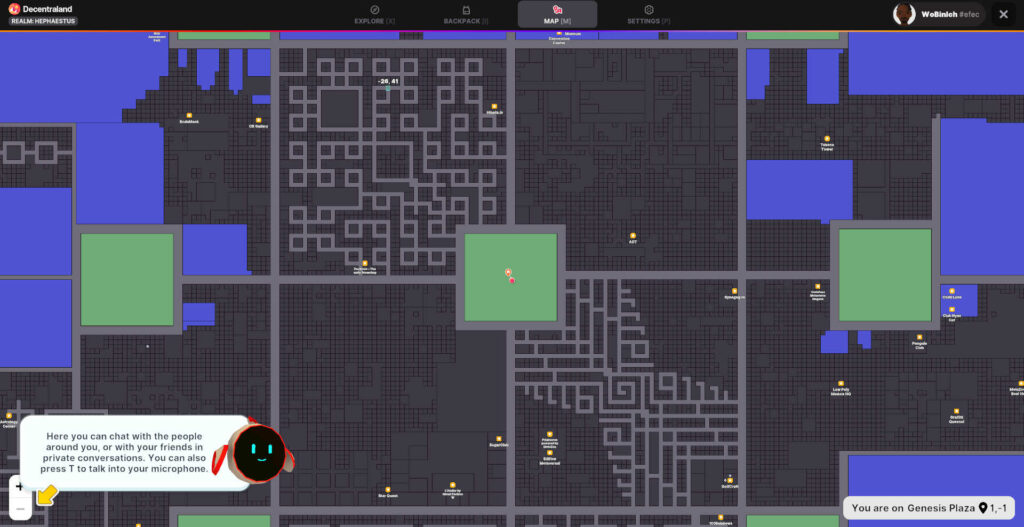
Despite the maximum zoom level, the map only shows a good third of the way to the Pro Senectute. In the chat, however, you can enter “/goto -38,120“, as one of the omnipresent in-game advertising posters will explain to me later. (The owners of some Decentraland parcel want to lure me from the “central” Pro Senectute vicinity to their actual location, probably also somewhere else “central”).
The double lot currently consists only of a black wall, with a floating(!) writing “Pro Senectute beider Basel” in front and a shy “Under Construction” sign next to it, evoking memories of 90s websites.
The environment of the online presence (or better, absence?) of Pro Senectute is still relatively empty. Why the choice fell on this “site” is not clear to me. Neither the neighboring Canadian law firm, nor the advertising for a menstruation app behind it really seems tailored to Swiss seniors.
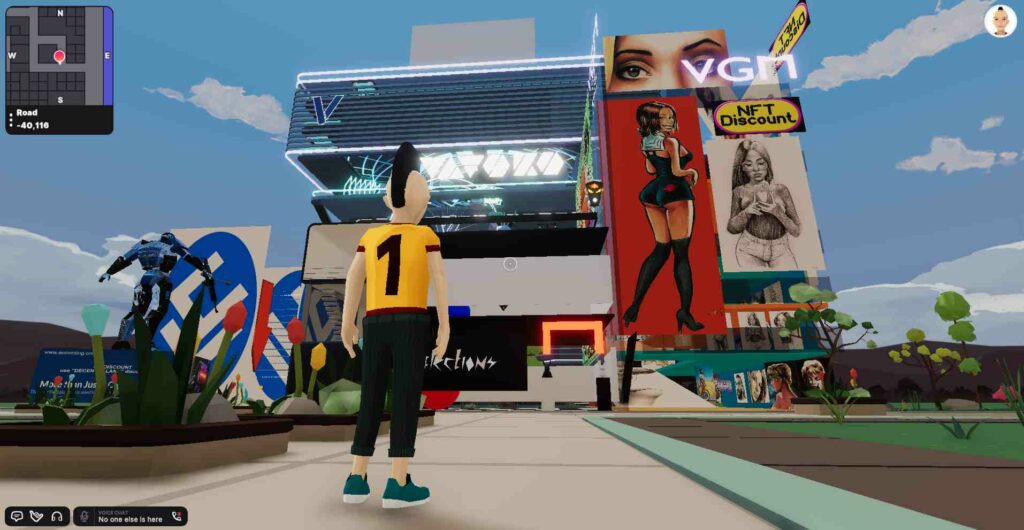
But maybe some of the male senior citizens will admire the oversized pin-up girl of the NFT discount store a few steps in the southeasterly direction of the plot. At least one can spend some of the waiting time until the opening of the course center.
Metaverse 2: The Sandbox
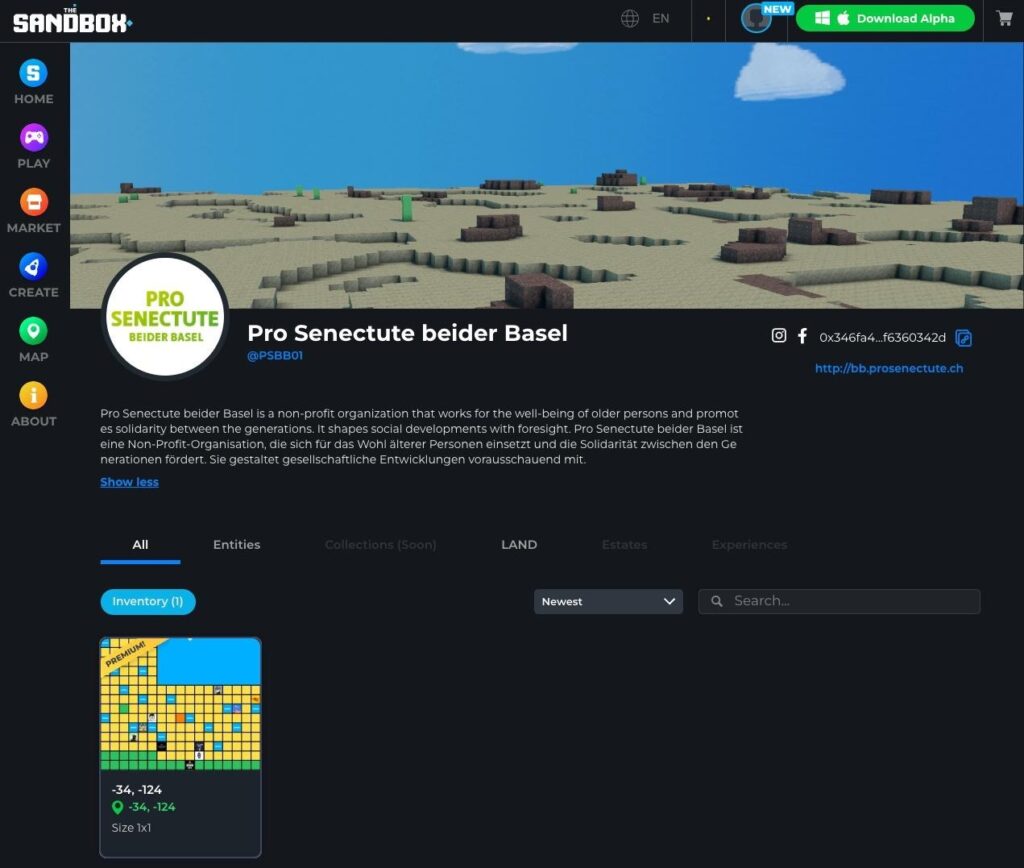
For The Sandbox, you are forced to create an account, which we managed only after several attempts. Then it turns out that a separate application is needed, which is not compatible with my computer.
A colleague has a compatible computer and can finally start playing after several gigabytes of download. However, the operation of The Sandbox is not intuitive enough for him to navigate to the “premium” coordinates of Pro Senectute.
If two computer scientists are already reaching their limits, what does it look like for senior citizens? Presumably, they first have to go to the physical course center in downtown Basel, where they are then told how to get to the virtual course center.
Early metaverses
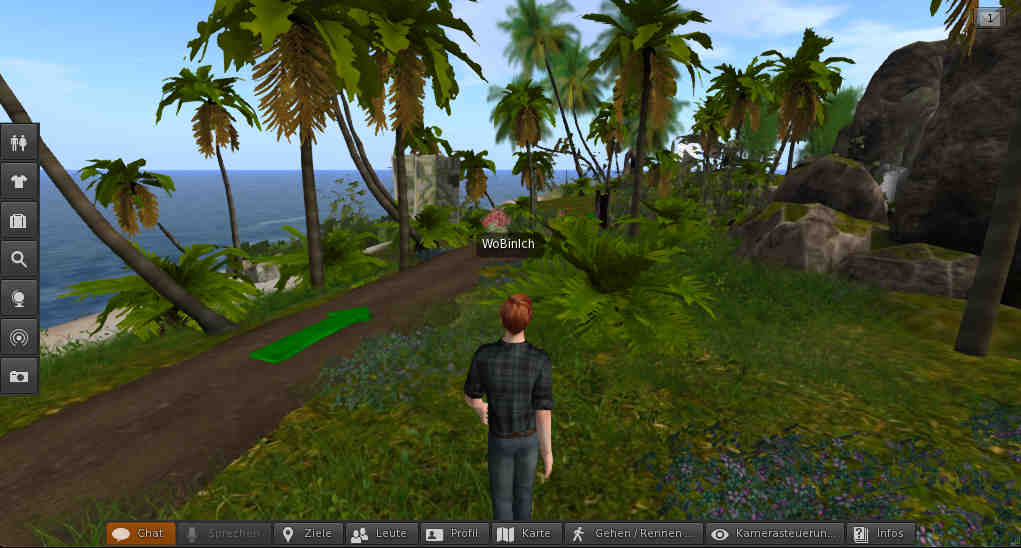
Since the 1980s, online games have been used for the first social interactions, at that time still text-based. Online worlds then experienced a somewhat greater degree of popularity starting in 2003 with the 3D world of Second Life or with online role-playing games like World of Warcraft. Today’s metaverses hope to escape this niche existence.
Both Second Life and World of Warcraft, though much older, feature more realistic (and in my opinion, friendlier) graphics than the Pro Senectute selection.
Interaction metaverse
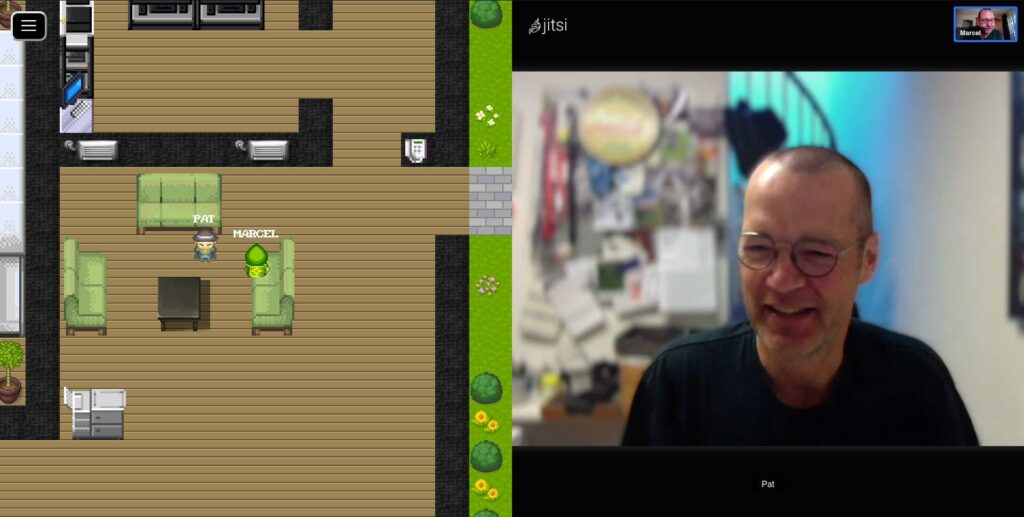
Spring 2020 marked the beginning of home office for many. With Workadventure, a few Frenchmen created a platform that allowed them to recover some of the social aspects of their usual office into their home office. The result was an open platform where anyone could create their own 2½D scenes. Most implementations recreated office worlds with meeting rooms and lounges. Anyone hanging around in the same lounge would automatically join a joint video conference, a very natural form of interaction. In addition, however, there is also possibility to connect objects with websites or other workadventures: Pinboards can thus display information from the intranet or doors lead to other Workadventure metaverses, in the open style of the web and its links. All with the goal of enabling informal social exchange in clear yet friendly virtual worlds.
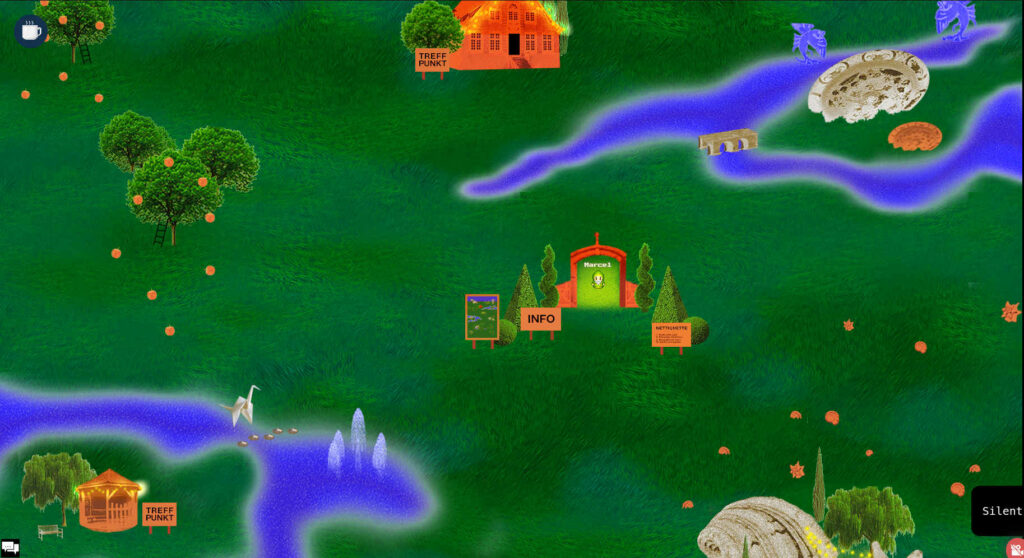
What is an NFT?
The Pro Senectute beider Basel online presence will be funded through NFTs, artworks designed specifically for this campaign that can be traded on the blockchain.
“NFT” stands for “Non-Fungible Token”, roughly a “non-exchangeable token”. The “non-exchangeable” serves to distinguish it from “normal”, exchangeable tokens such as digital coins: Any digital dollar can be exchanged for any other digital dollar and no one will notice.
These NFTs are being marketed by some as the future of digital art (and for much more). For this purpose, a program is stored on the blockchain, a so-called “smart contract”, through which these works of art can be traded. These trade changes and the payments made for them are also stored back on the Blockchain. Interestingly, however, the artwork itself is not in the blockchain; only the URL (web address) is stored in the smart contract.
Thus, an art NFT and its smart contract:
- Public: A public, normal web link (URL), usable by anyone, to a computer file of a work of art that can be changed at any time.
- Perpetual: The NFT is managed by a public “digital contract” (“smart contract”). These smart contracts and each associated transaction are elaborately (and contrary to ideas of privacy) kept publicly and virtually immutable in a blockchain “forever.” (But that alone is not enough for them to also retain their function).
- Program: This smart contract is a piece of cryptic program code that often is not even properly understood by its developers, let alone estimate its consequences (Background).
The NFT (and the underlying smart contract), on the other hand,do not provide (sometimes or always):
- Right of use: The usage rights which you gain from this NFT or its contract are rarely precisely defined.
- Hurdle: The contract, however, does not pose a technical hurdle to viewing or even downloading the artwork. On the contrary, it points every blockchain user to where the artwork can be downloaded.
- Trustworthiness: Some of these smart contracts “simply” charge a fee when they are resold (sometimes as a surprise); others are actively malicious (e.g., they steal crypto-money or NFTs); quite a few are buggy and can be abused by hackers. An ordinary user does not have the tools to determine this before bindingly interacting with the contract.
- Bug fixes: Many smart contracts do not offer the possibility of a software update, which could correct errors or security vulnerabilities. This is because this update option can also be (and has already been) abused.
- Goodwill: There is no cure for faulty or malicious smart contracts. Not even against simple typing errors during the transfer. Recourse is impossible, so is an appeal to a court. Hoping for generosity on the part of the other party is also impossible by design: The smart contract program, once started, acts completely stubbornly and autonomously and cannot be influenced by anything or anyone (“Code is Law”: The program code is the only valid, first- and last-instance law).
- Contract: This “digital contract” probably does not even correspond to what the Code of Obligations understands by a contract, since consent to such an incomprehensible construct cannot be seen as an expression of will. In the event of deceipt (which is easily possible with smart contracts), there is also no possibility for subsequent correction, for example by annulling or correcting the contract.
- Uniqueness: The alleged uniqueness of NFTs is an illusion. Likewise, without additional, sometimes time-consuming research, it is not possible to verify whether the creator of the NFT is also the owner of the copyright or right of use to the work of art. (In other words, the fact that something is sold as an NFT says nothing about its authenticity or whether it is copied/faked).
- Free of charge: Transactions around smart contracts (even just moving them between the owner’s left and right pocket) cost money, or more precisely, “cryptocurrencies”. These are not currencies in the classic sense, as they lack both a functioning monetary cycle and the necessary stability.
- Value: Quantifying the value of art reliably and objectively is already an impossibility. It becomes even more difficult when the yardstick for this, the cryptocurrency, is itself highly speculative and can only be kept alive, as it were, by a snowball system.
- Simplicity and democracy: This blockchain was created in 2008 as an alternative to an economic system dominated by a few people and characterized by greed, inefficiency, intransparency and excessive complexity. However, the economic system created by blockchains is riddled with concentrated greed, inefficiency, intransparency, and unnecessary complexity. And, despite the regularly repeated promises of fairness and democratization through the blockchain, the financial power behind it is in the hands of very few people with sometimes very strange ideas about the society we should all live in.
In short, a very complex, opaque and unclear system is being set up without any possibility for appeal or mercy, which tramples on our rights to privacy and – despite all protestations of fairness and distribution – actually only benefits a few (newly) rich.
The use of NFTs does not fundamentally change the problems of funding the arts or nonprofit organizations: Neither the often unfair access to audiences, the often unfair pay, nor the often difficult access to upfront investment. It also isn’t a step into an entirely new arts culture or arts funding culture. (Or, in the case of Pro Senectute, donation culture).
On the contrary, in my opinion, it is not only without benefit, but even harmful to society in the long term.
Goals reached?
Now, do NFTs and the selected metaverses fulfill the goals of Pro Senectute beider Basel? Let’s first look at the goals around the NFTs:
NFT goals
A. Unique property?
In its media release, Pro Senectute beider Basel writes: “An NFT maps a digital certificate of ownership and thus represents a unique, non-copyable original on the blockchain.”
Let’s take this one step at a time:
Certificate of ownership: What rights one acquires to the work through the action is not clear from either the media release or the NFT website. My request for clarification was not answered.
Unique: Thereare up to 2512 copies of the individual works. Can one really speak of “unique”‽
Not copyable: The NFT stored on the public blockchain only points to a “normal” (also public) URL. A download (and thus the creation of a local copy) is therefore possible from any computer without restrictions.
Original: In the digital world, there is no difference between original and copy.
On the Blockchain: the works themselves are not on the Blockchain, only references and proofs of purchase.
In short: the sentence from the media release bears—generously speaking—barely any relation to reality.
B. Asset value?
Also mentioned in the media release are “unique virtual assets”. Again, this raises questions about the valuation of the NFT within a volatile or illiquid secondary market and thus whether the NFT really represents an asset.
I would not want the three most common NFTs even if gifted, even less so for money. (Nevertheless, I bought one of the NFTs — for analysis purposes).
C. Paper Wallet
The NFTs are sent as a “paper wallet“; a QR code printed on high quality paper for viewing the work and a scratch area which initially hides the information required for resale.
Such a paper wallet has the advantage that the buyers do not have to take care of the cryptocurrencies and crypto wallets (=online cryptocurrency account). However, it also has the disadvantage that one only finds out after a fee-based “resale” to oneself whether one has really acquired a right to this NFT or whether the same envelope with the same access data was simply sent out 4444 times.
Also unclear is how many hands the secrets under the scratch field passed through before the scratch was applied (contogeneration, transmission, printing process) and how many people could thus also lay a digital claim to the artwork. (The blockchain does not say who is the rightful owner now; any person who knows the secrets under the scratch-off can resell it on their behalf).
In response to my question, Michael Harr explained that he was prepared. A print shop had been chosen that also handled sensitive data (e.g. lottery tickets) and could guarantee confidentiality. In addition, further security measures were taken. The paper wallets also had some credit so that no additional costs would be incurred for the first transfer of ownership worth around one centime.
However, the question about the rights acquired with the NFT and the characteristics of the smart contract remained unanswered and thus unclear.
D. New channels?
Does this action really bring in additional revenue from “new channels”? Since the beginning of the year, the NFT market has slumped by 97%. Despite this, “the land costs have practically already been recouped” through the NFT sales, according to Harr.
Pro Senectute beider Basel will inform about the outcome after the end of the activity, which will last at least until spring. Only then we will have a chance to determine whether this has led to additional revenue or whether those willing to donate have simply changed their method of giving.
But even that conclusion will hardly show whether these new channels are sustainable or just a flash in the pan.
Metaverse goals
A. Participation in progress?
The media release motivates the creation of these “Metaverse branches” with “let[ting] the older generation actively participate [in] technological advances.”
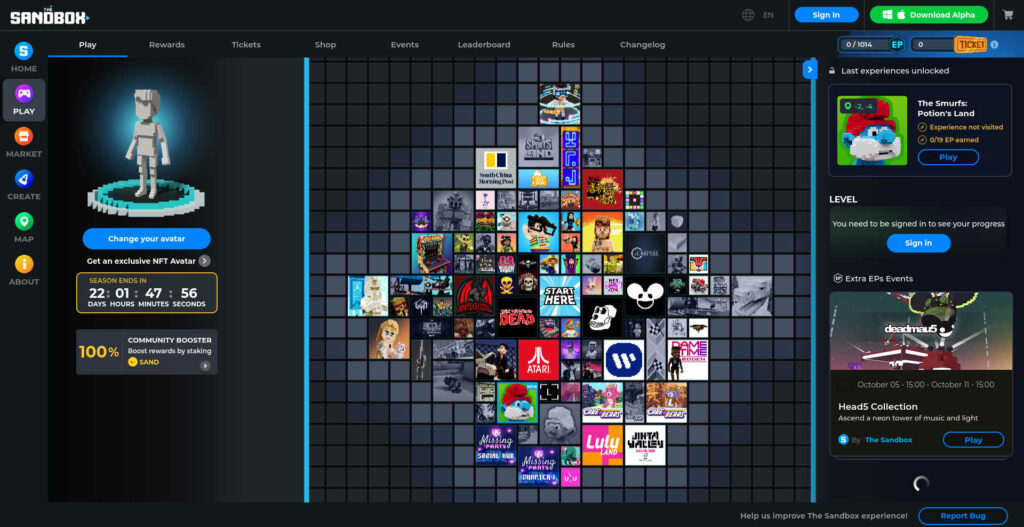
Both platforms try to motivate players to spend cryptocurrency on all sorts of in-game extras. If you are not careful, you can quickly lose a lot of money.
In particular, The Sandbox seems to be a Minecraft clone trimmed for monetization, coming across on the splash page with the combined charm of a back-alley gambling joint and a Formula-1 overall.
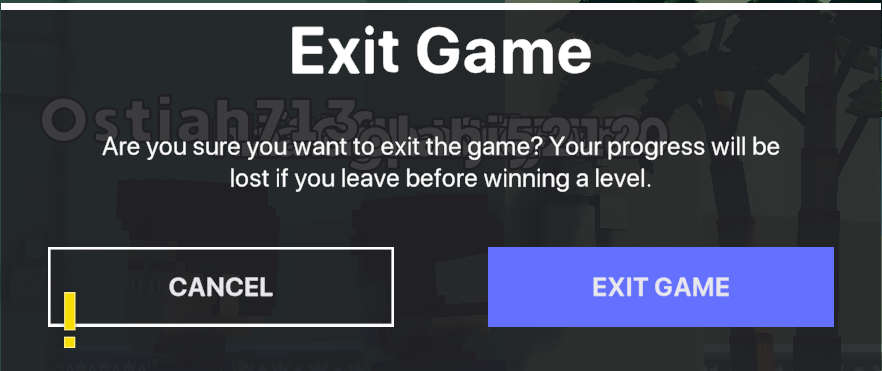
We beg to question whether these two rather bleak, English-only worlds with their obtrusive monetization, omnipresent advertising, and sometimes rather unintuitive interface are really (1) the ideal environment to lure seniors into and (2) give these platforms as well as the underlying cryptocurrencies legitimacy through one’s presence.
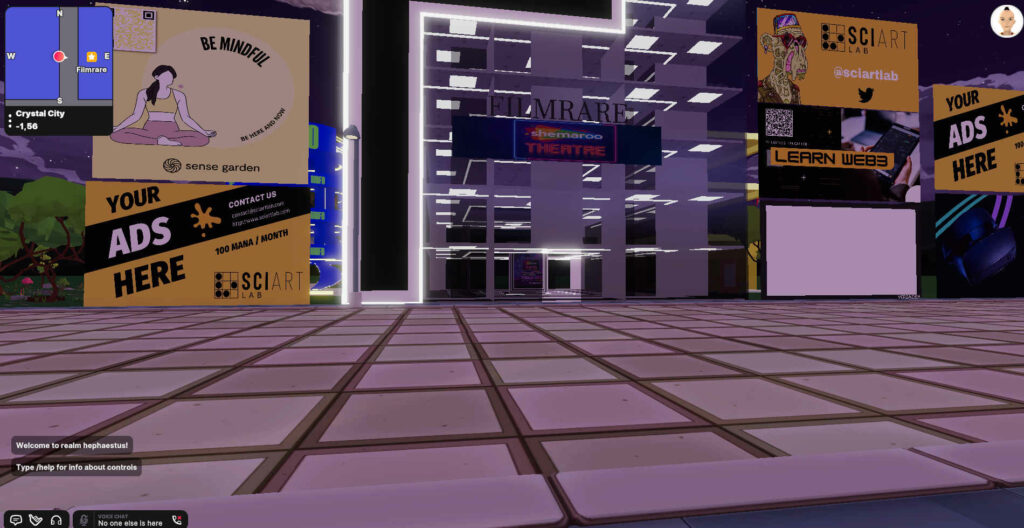
The abilities to critically scrutinize, tend to decline with age (think of the inglorious grandparent scams). Exposing possibly cash-strapped seniors to such heavily monetized platforms seems dangerous, to say the least, especially if other participants on these platforms then try to lure these seniors with possible extravagant profits (through money games or NFT “investments”).
B. Prediction for 40 years?
In the shockingly uncritical SRF News article, Michael Harr’s target audience is quoted as “people who are 30 or 40 years old today will use when they themselves are of retirement age”.
I think it is extremely daring to try and predict today which technologies will still be relevant in 30 to 40 years.
Looking back, 40 years ago, the end of the Iron Curtain was unimaginable and the Internet in its current form had not yet been born; 30 years ago, the WWW was just one year old and known only to some insiders. Today, hardly anyone can imagine that smartphones with touchscreens have only been around for 15 years, much shorter than the forecast period.
It is impossible today to make predictions about whether a specific platform of a given technology selected now will even exist then, especially when even large platforms face an uncertain future.
C. Central location?
“They are central locations in the metaverse, comparable to downtown locations in the real world,” says Michael Harr, executive director of Pro Senectute beider Basel.
In the metaverse, you can be teleported to any possible coordinate at any time within a few seconds. At first glance, this seems to imply that the concept of “central location” completely loses its meaning we have from the real world. Nevertheless, there are significant price differences between properties at different locations. Researchers at the University of Basel, for example, have analyzed the prices of the original auction that was used to find many Decentraland “properties” their first owners five years ago.
They published their conclusions last year, long before the current Pro Senectute purchases: Buyers were willing to pay significantly higher prices for a “good location” in 2017.
Fabian Schär, one of the authors of the study, explains: “The metaverse is an attention economy. Similar to the physical world, those parcels that have a high density of visitors, i.e. are located near large squares, main roads or important districts, are particularly sought-after. In addition, parcels with memorable coordinates also fetch significantly higher prices. This aspect is reminiscent of markets for domain names where similar effects can be observed.”
Regardless of location, all land purchases in the Metaverse are high-risk investments, he adds. “As interesting as the subject matter may be, potential buyers of virtual land parcels must always be aware that they can lose everything.”
According to a recent study by Wemeta, the value of The Sandbox and Decentraland properties has plummeted by 80% and demand has also declined, in Decentraland by a factor of 6.
How “central” is the location really? The Pro Senectute properties in Decentraland are only 10% away from the “northern” edge.
The coordinate -38,120 doesn’t seem particularly memorable either, so that can’t be it either.
The Canadian lawyer’s office or the menstruation app “west” of the Pro Senectute location are also unlikely to attract many walk-in customers. Nor will the aforementioned abandoned Anarchy NFT Café with its viewing terrace or the NFT Discount with its pin-up girl storefront. The use of the buildings in the direction of “north” is unclear and in the direction of “east” is undeveloped steppe as far as the eye can see.
“Central?” Apparently not. Further research shows: The steppe to the east is actually a huge university campus. The map shows no points of interest, so I take a stroll. Some zig-zagging later, I discover an (empty) building with a periodic table and a lectern. But even that will hardly attract streams of visitors.
D. Reduce isolation?
In the press release, Michael Harr, the foundation’s manager, is quoted as saying: “We want to promote the integration of the older generation and reduce social isolation.”
The seniors I interviewed expressed their belief that such worlds would promote isolation instead. Some had already enjoyed using an online Jass app remotely. Together with a parallel audio or video call, this had almost recreated the pleasurable feeling of sitting at a table together.
For seniors who are no longer confident enough to operate a tablet, there are also approaches for senior-friendly video telephony solutions.
E. Experiences despite limitations?
“Thanks to VR glasses, people with disabilities can experience things that are not possible in analog. It is conceivable, for example, that an elderly person in a wheelchair can experience the view from a mountaintop thanks to VR glasses,” explains Michael Harr in a response to my inquiry.
A very laudable goal, but do we need a Metaverse for this? Back in 1978 (!), a 3D virtual tour of Aspen was created. Without having to raise from the armchair (or wheelchair), it was possible to explore the entire city. Completely without Metaverse. More than 25 years ago, the necessary technology became available on widely used computers.
The view from the top of the mountain (or even the way there) could be experienced without a metaverse, without anything but a web browser. Not every 3D representation has to be locked into a commercial platform. “Locking in” also aptly describes the minute amounts of data that can be stored for a Decentraland parcel; far too little for a realistic mountain panorama. (This limit also explains why the five year old world still shows only minimalistic graphics).
F. Digital course/consultation center?
The Decentraland property of Pro Senectute is 16×32 m². The (small-looking) auditorium mentioned above is twice the size; some form of classroom could certainly be accommodated in half of it. The question is rather, how would courses be held there? So far, there seem to be no mechanisms in Decentraland that support knowledge transfer, even ignoring the already mentioned very restrictive storage limits). It is also hard to imagine that better knowledge transfer than with specialized tools (or even just a video conference) will ever be possible in these metaverses.
Conclusion
The fundamental question is whether a world of hypercapitalism is the right environments to attract seniors into: Their more or less subtle ubiquitous monetization of almost every corner, their aspects of gambling, and their attempts at sensory overload, especially through omnipresent advertising does not seem a platform I would feel comfortable advertising to a wide range of seniors. Instead, if I had the say at an organization catering to a wide spectrum of elderly people, I would propagate a reduced, more comprehensible, intuitive and user-friendly environment, catering for the reduced receptiveness and critical faculties of age.
Seniors I interviewed would rather enjoy the sun than invest so much time in a confusing system. For digital communication, they would prefer the telephone or a video call. Incidentally, such a call is also an excellent basis for starting a joint online Jass.
None of these statements should be taken as endorsement to keep interested seniors from exploring online worlds, on the contrary. My respondents, if they had to visit one of the Metaverses, would prefer the more intuitive, natural environment of Second Life over Decentraland any day.
Many of the other statements of Michael Harr were — as explained above — hard for me to understand. Therefore I asked the Pro Senectute beider Basel for further information. I hoped that they could give me information about concepts or background considerations, the total costs and their financing. If the initial financing was “not from donations”, then where was it from? (Hopefully also not from the operation of the retirement homes or the earmarked public funds, the three together making up about 90% of the foundation’s budget). Likewise, I asked for information about what the features (and costs) of the smart contract were, as well as how the security of the production process of the paper wallet would be ensured. The response 1½ weeks later rarely addressed my specific questions. A commendable exception is the explanation of the paper wallets and that the wallets have been topped up with sufficient cryptocurrency so the buyer can transfer ownership once without going through further hoops or expenses.
As with many other projects in the blockchain environment, the question about who will benefit from the project remains unanswered: Will only the early entrants and the consultants earn anything, or will it add a sustainable value to our society.
Part of this ambiguity probably arises from the lack of clear distinction in communication between what is being worked on today and where Pro Senectute beider Basel sees itself in 30 or 40 years.
Many ambiguities could have been clarified by a statement such as, “With a portion of the maximum 300,000 francs from the NFT proceeds, we want to explore how we might best interact with seniors a few decades.” At present, neither such a statement nor apparently a sufficiently deep understanding of what the various envisioned technologies can and definitely cannot do seem to exist.
If hyped technology and its effects are only superficially understood, there is a great risk of incorrect assessments and wrong decisions. It remains to be hoped that, despite the signs to the contrary, the added value for society will prevail in this case. And perhaps there will be some money left over for the current generation.
Blockchain ecosystem
More posts in the blockchain ecosystem here, with the latest here:
- The year in review
 This is the time to catch up on what you missed during the year. For some, it is meeting the family. For others, doing snowsports. For even others, it is cuddling up and reading. This is an article for the latter.
This is the time to catch up on what you missed during the year. For some, it is meeting the family. For others, doing snowsports. For even others, it is cuddling up and reading. This is an article for the latter. - NFTs are unethical
 As an avid reader, you know my arguments that neither NFT nor smart contracts live up to their promises, and that the blockchain underneath is also more fragile and has a worse cost-benefit ratio than most believe. Similarly, I also claim the same for the metaverses built on top of them all. And that the… Read more: NFTs are unethical
As an avid reader, you know my arguments that neither NFT nor smart contracts live up to their promises, and that the blockchain underneath is also more fragile and has a worse cost-benefit ratio than most believe. Similarly, I also claim the same for the metaverses built on top of them all. And that the… Read more: NFTs are unethical - Inefficiency is bliss (sometimes)
 Bureaucracy and inefficiency are frowned upon, often rightly so. But they also have their good sides: Properly applied, they ensure reliability and legal certainty. Blockchain disciples want to “improve” bureaucracy-ridden processes, but achieve the opposite. Two examples:
Bureaucracy and inefficiency are frowned upon, often rightly so. But they also have their good sides: Properly applied, they ensure reliability and legal certainty. Blockchain disciples want to “improve” bureaucracy-ridden processes, but achieve the opposite. Two examples: - The FTX crypto exchange and its spider web
 Yesterday, the U.S. Securities and Exchange Commission (SEC) released its indictment against Sam Bankman-Fried. It details the financial entanglements of FTX, Alameda Research and more than a hundred other companies and individuals. We have tried to disentangle these allegations somewhat for you.
Yesterday, the U.S. Securities and Exchange Commission (SEC) released its indictment against Sam Bankman-Fried. It details the financial entanglements of FTX, Alameda Research and more than a hundred other companies and individuals. We have tried to disentangle these allegations somewhat for you. - Web3 for data preservation? (Or is it just another expensive P2P?)
 Drew Austin raises an important question in Wired: How should we deal with our accumulated personal data? How can we get from randomly hoarding to selection and preservation? And why does his proposed solution of Web3 not work out? A few analytical thoughts.
Drew Austin raises an important question in Wired: How should we deal with our accumulated personal data? How can we get from randomly hoarding to selection and preservation? And why does his proposed solution of Web3 not work out? A few analytical thoughts. - Rejuvenation for Pro Senectute through NFT and Metaverse?
 Pro Senectute beider Basel, a foundation to help the elderly around Basel, launched its NFT project last week and already informed about its Metaverse commitment beforehand. According to a media release, Michael Harr, managing director of the 15-million Basel-based company, wants to use the purchase of these “properties” in a “central location” in two online… Read more: Rejuvenation for Pro Senectute through NFT and Metaverse?
Pro Senectute beider Basel, a foundation to help the elderly around Basel, launched its NFT project last week and already informed about its Metaverse commitment beforehand. According to a media release, Michael Harr, managing director of the 15-million Basel-based company, wants to use the purchase of these “properties” in a “central location” in two online… Read more: Rejuvenation for Pro Senectute through NFT and Metaverse?

